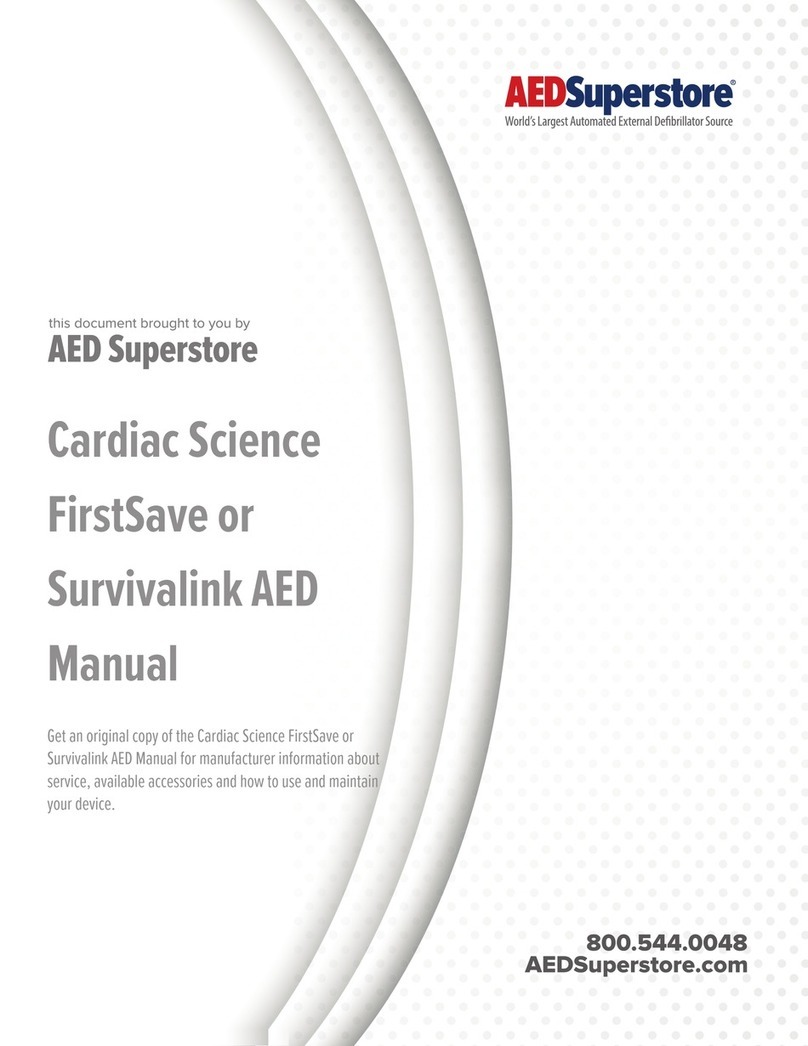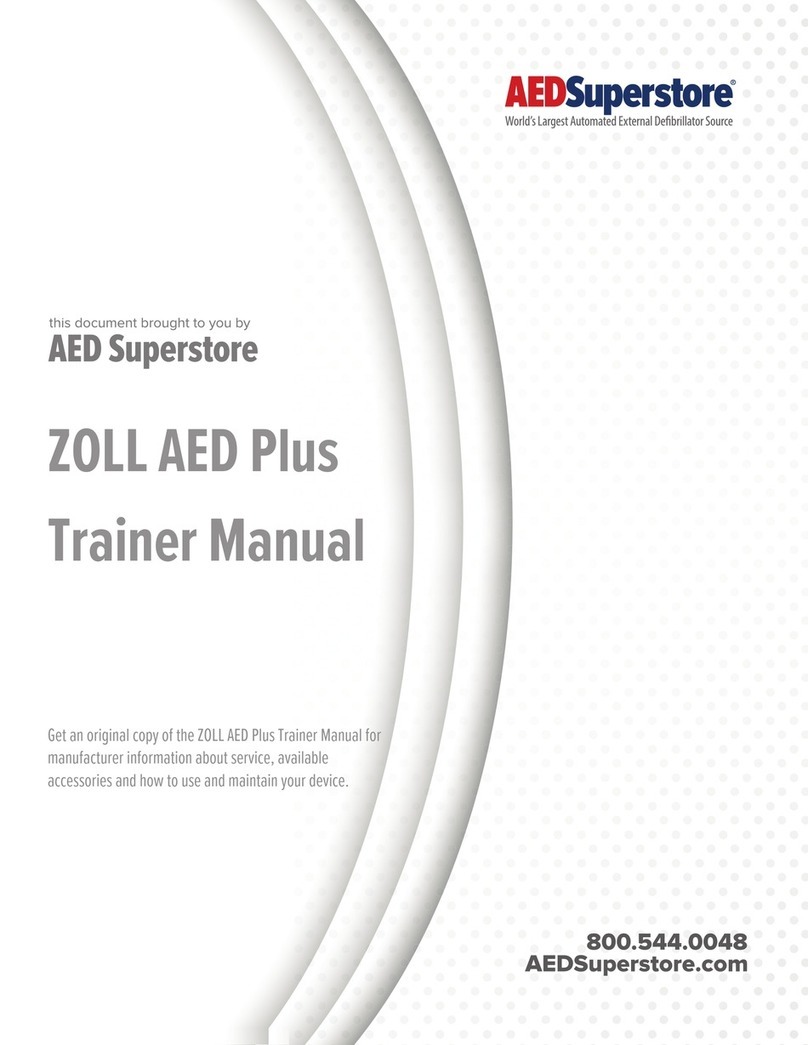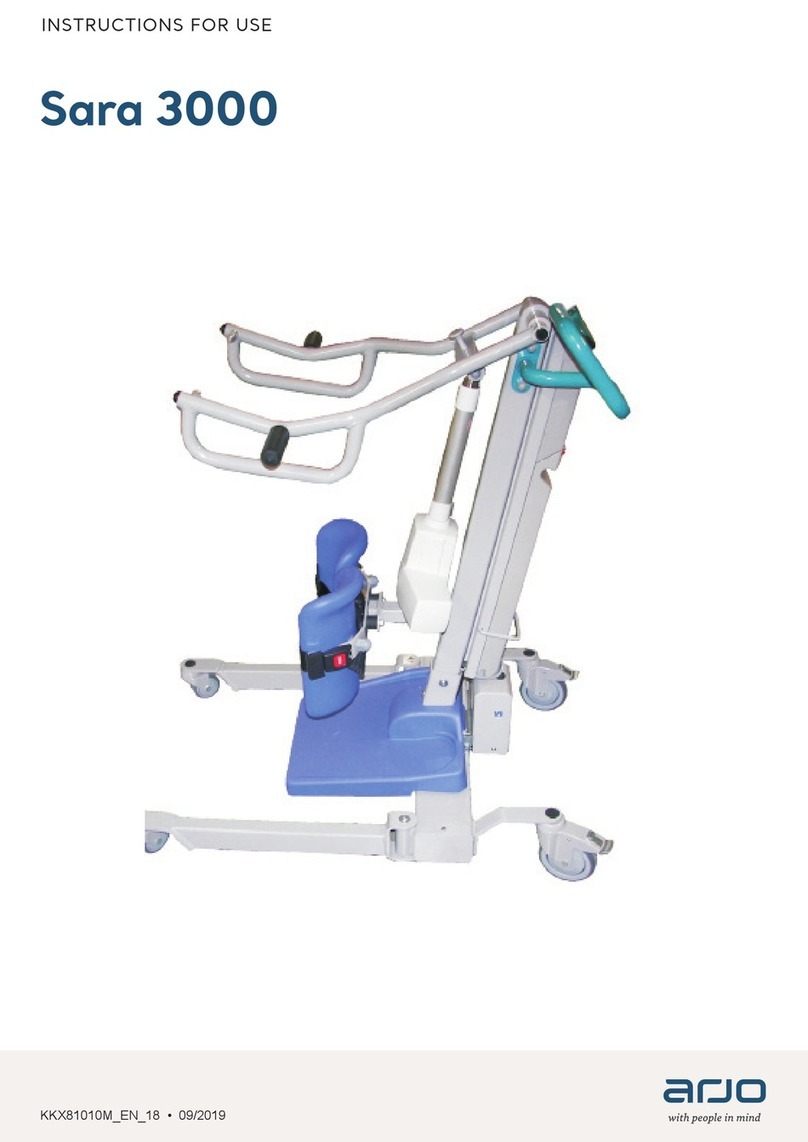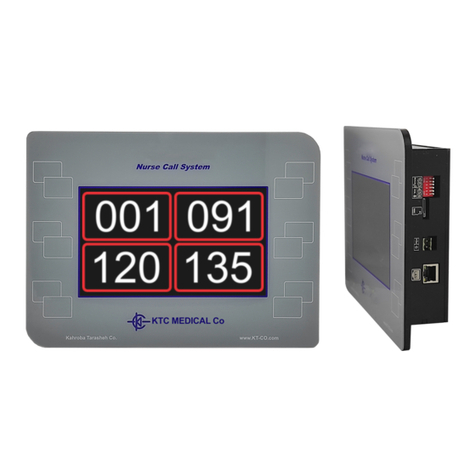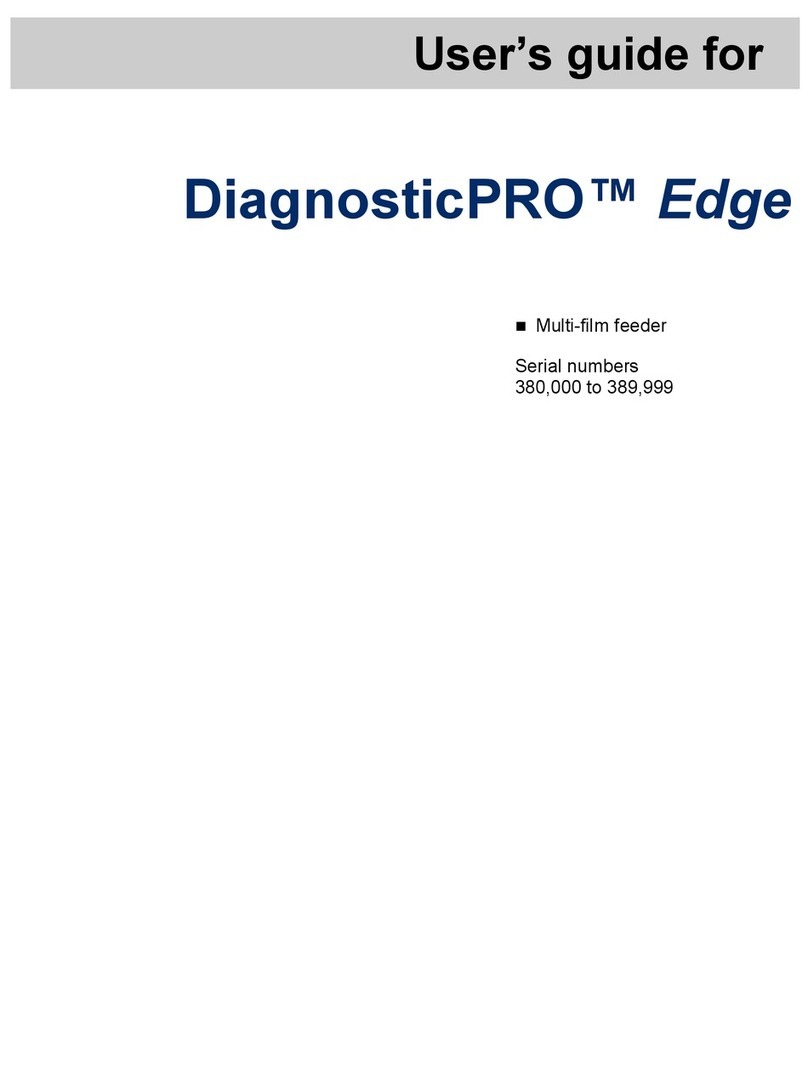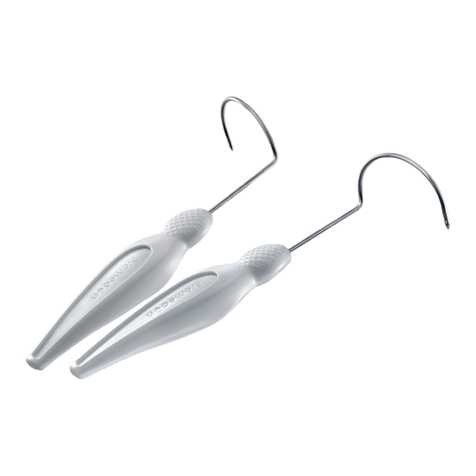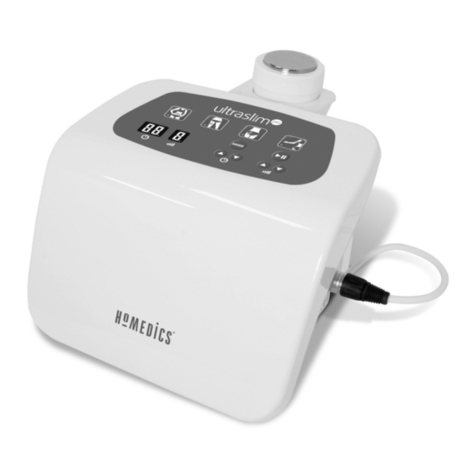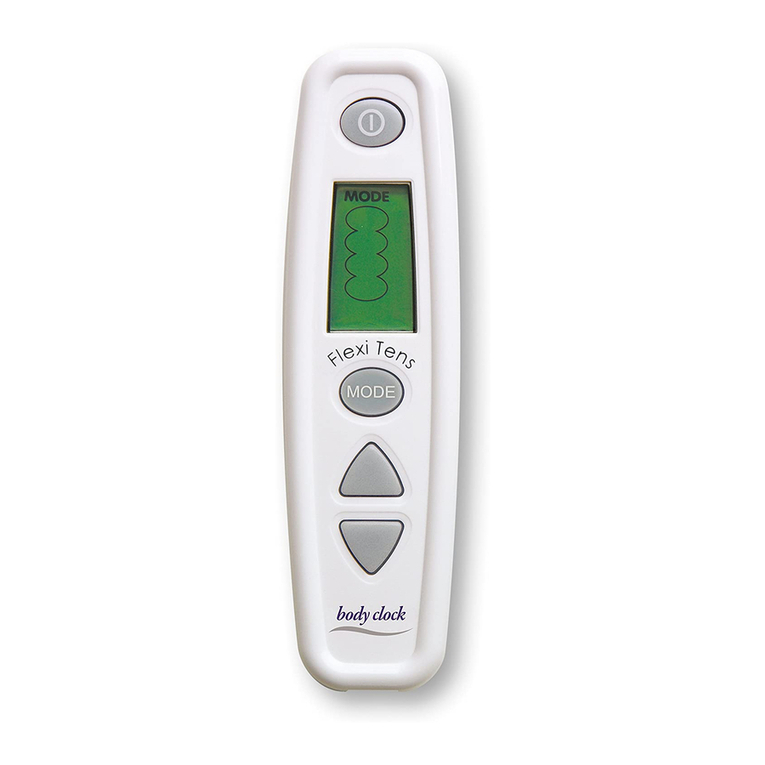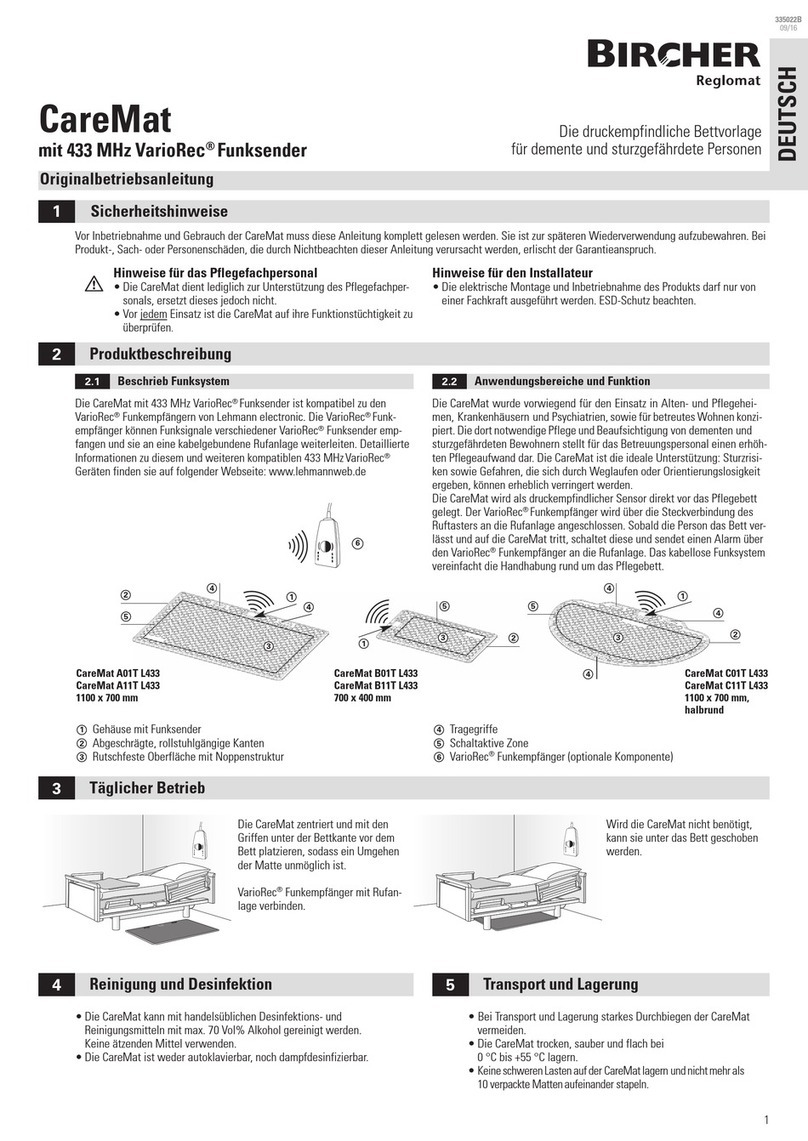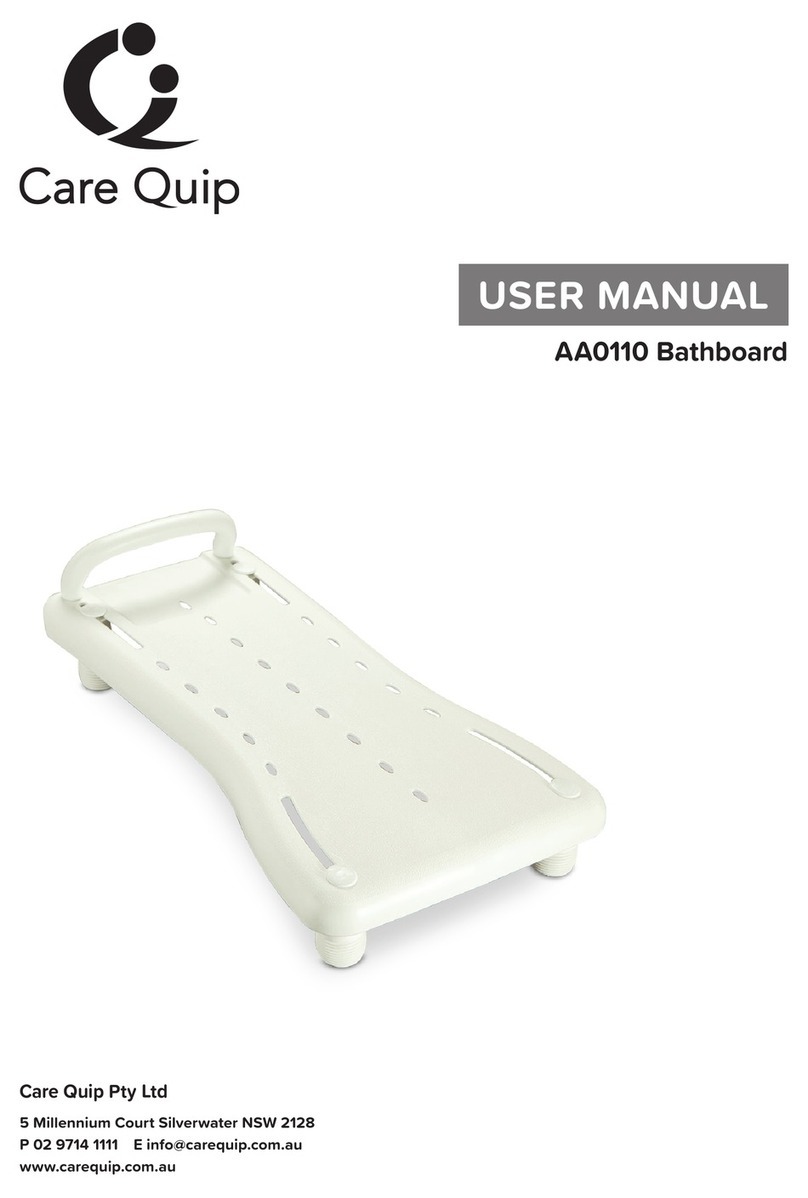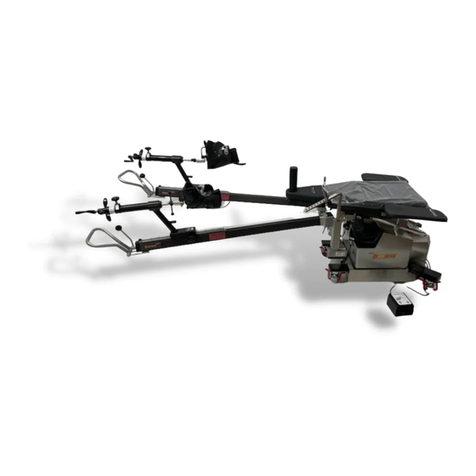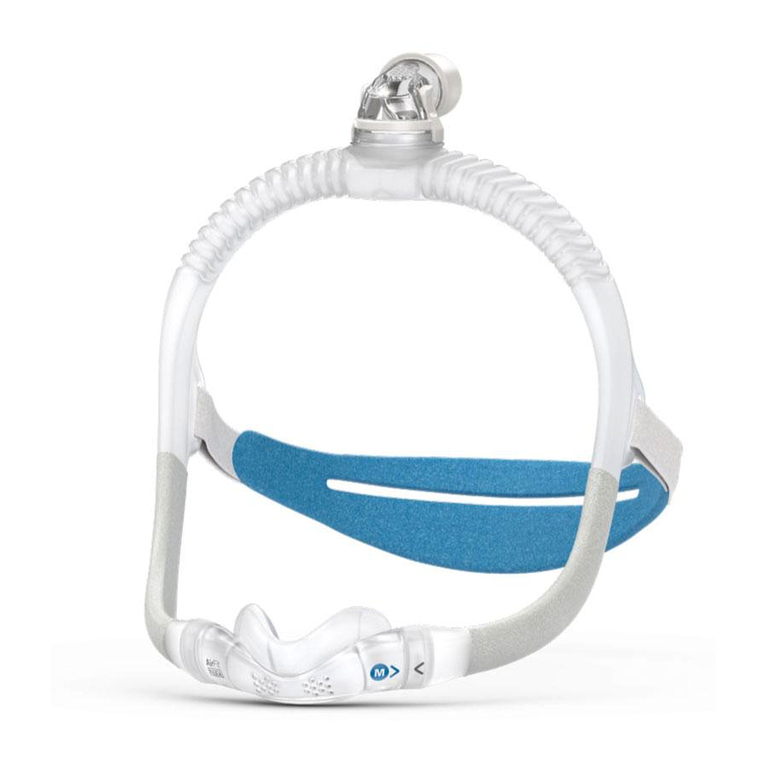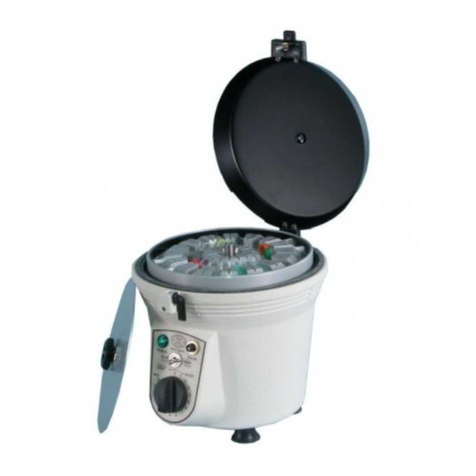AED Superstore Defibtech DDU-2300 User manual

Defibtech
Lifeline VIEW
AED Manual
Get an original copy of the Defibtech Lifeline VIEW AED
Manual for manufacturer information about service,
available accessories and how to use and maintain your
device.

User Manual
For comprehensive training on set-up,
use and maintenance; source for
complete technical specifications
Defibtech DDU-2000 Series
Automated External Defibrillator
• DDU-2300
• DDU-2450
DAC-A2510EN-BG
ELECTRONIC
DISTRIBUTION

1
2
3
PRESS “ON”
BUTTON
APPLY PADS
FOLLOW AED
INSTRUCTIONS
2
DAC-A2510EN-BG

Notices
Defibtech, L.L.C. shall not be liable for errors contained herein or for incidental or consequential damages in
connection with the furnishing, performance, or use of this material.
Information in this document is subject to change without notice. Names and data used in any examples are
fictitious unless otherwise noted.
Limited Warranty
The “Limited Warranty” shipped with Defibtech AED products serves as the sole and exclusive warranty provided
by Defibtech, L.L.C., with respect to the products contained herein.
Copyright
Copyright © 2016 Defibtech, L.L.C.
All rights reserved. Copyright questions should be directed to Defibtech.
For contact information, refer to Chapter 13 of this manual.
Tracking
U.S.A. federal regulations require Defibtech to maintain records for each AED it distributes (reference 21 CFR 821,
Medical Device Tracking). These requirements also apply anytime there is a change in the AED’s location, including
if you move, sell, donate, give away, export or even throw it away. We depend on AED owners/users to contact
us when these things happen to ensure the tracking information remains accurate in the event we need to share
important product notices. If your location is outside the U.S.A., we ask you share your information for exactly the
same reasons. To keep your information up to date, please visit www.defibtech.com/register.
Federal Law (USA) restricts this device
to sale by or on the order of a physician.
Issued: 2016- 07-19
CAUTION
3
DAC-A2510EN-BG

Contents
1 Introduction To The DDU-2000 Series AED ......................................................6
1.1 Overview...........................................................................................................................6
1.2 The Defibtech DDU-2000 Series AED...............................................................................8
1.3 Usage .............................................................................................................................. 10
2 Dangers, Warnings, And Cautions...................................................................11
2.1 Dangers...................................................................................................................... 11
2.2 Warnings .................................................................................................................... 11
2.3 Cautions ..................................................................................................................... 12
3 Setting Up The DDU-2000 Series AED............................................................13
3.1 Overview......................................................................................................................... 13
3.2 Connecting The Defibrillation Pads .................................................................................. 14
3.3 Installing And Removing The Battery Pack ...................................................................... 14
3.4 Checking The DDU-2000 Series AED Status................................................................... 15
3.5 Installing The Defibtech Data Card (DDC Card) (optional)................................................ 16
3.6 Completing The Installation ............................................................................................. 16
3.7 Storing The DDU-2000 Series AED ................................................................................. 16
4 Using The DDU-2000 Series In AED Mode ......................................................17
4.1 Overview......................................................................................................................... 17
4.2 Preparation ...................................................................................................................... 19
4.3 Heart Rhythm Analysis.................................................................................................... 22
4.4 Delivering The Shock .......................................................................................................22
4.5 CPR Period ......................................................................................................................22
4.6 Post-Use Procedures.......................................................................................................23
4.7 AED Mode Voice And Text Prompts.................................................................................23
4.8 Operational Environment.................................................................................................27
5 ECG Monitor Mode (DDU-2450 only) ...................................................................28
5.1 Entering ECG Monitor Mode........................................................................................... 28
5.2 Applying The ECG Monitoring Electrodes .......................................................................28
5.3 Monitoring The Patient .................................................................................................... 29
6 Maintenance And Troubleshooting .................................................................30
6.1 Routine Unit Maintenance...............................................................................................30
6.2 Self-Tests.........................................................................................................................34
6.3 Cleaning ..........................................................................................................................34
6.4 Storage............................................................................................................................ 34
6.5 Operator’s Checklist ........................................................................................................35
6.6 Troubleshooting...............................................................................................................36
6.7 Repair ..............................................................................................................................37
CAUTION
!
DANGER
!
WARNING
!
CAUTION
!
DANGER
!
WARNING
!
CAUTION
!
DANGER
!
WARNING
!
4
DAC-A2510EN-BG

7 Maintenance Mode ..........................................................................................38
7.1 Overview......................................................................................................................... 38
7.2 Navigation (in Maintenance Mode)..................................................................................38
7.3 Entering Maintenance Mode........................................................................................... 39
7.4 AED Main Menu Screen .................................................................................................39
7.5 AED Status Screen.......................................................................................................... 39
7.6 AED Maintenance Screen ...............................................................................................40
7.7 AED Options Screen ....................................................................................................... 42
7.8 Rescue Options Screen...................................................................................................45
7.9 Help Topics Screen ..........................................................................................................47
8 DDU-2000 Series AED Accessories.................................................................48
8.1 Defibrillation Pads............................................................................................................ 48
8.2 Battery Packs................................................................................................................... 48
8.3 Rechargeable Battery Pack ..............................................................................................48
8.4 Data Cards....................................................................................................................... 48
8.5 USB Cable ....................................................................................................................... 49
8.6 ECG Monitoring Adapter .................................................................................................49
9 Event Viewing ..................................................................................................50
9.1 DefibView........................................................................................................................ 50
9.2 Defibtech Data Cards (DDC Cards) .................................................................................50
9.3 Downloading The Internal Data Log ................................................................................50
10 Technical Specifications..................................................................................51
10.1 Defibtech DDU-2000 Series AED....................................................................................51
10.2 Battery Packs...................................................................................................................56
10.3 Self-Adhesive Defibrillation Pads.....................................................................................56
10.4 ECG Monitoring Adapter / Cable (optional)......................................................................56
10.5 Event Documentation ..................................................................................................... 57
10.6 Defibtech Event Viewer ...................................................................................................57
10.7 Recycling Information......................................................................................................57
10.8 Notice To European Union Customers ............................................................................57
11 Electromagnetic Conformity...........................................................................58
11.1 Guidance And Manufacturer’s Declaration ...................................................................... 58
12 Glossary Of Symbols .......................................................................................61
13 Contacts ..........................................................................................................63
5
DAC-A2510EN-BG

6
1 Introduction To The DDU-2000 Series AED
This User Manual provides information to guide trained operators in the use and maintenance of the Defibtech
DDU-2000 Series Automated External Defibrillator (AED) and its accessories. It includes comprehensive training
on set-up, use, and maintenance and is the source for complete technical specifications.
This chapter includes intended use, an overview of the AED, a discussion of when it should and should not be used,
and information on operator training.
1.1 Overview
The DDU-2000 Series AED is a Semi-Automatic External Defibrillator that is designed to be easy to use, portable,
and battery powered. Push-button controls include an ON/OFF button, three softkey buttons, and a SHOCK button.
Voice prompts, text prompts, and a display screen with visual prompts provide a simple interface for the operator.
The DDU-2000 Series AED is capable of recording event information, including ECG, audio data (optional), and
SHOCK/NO-SHOCK recommendations.
The DDU-2000 Series of AEDs includes the following models:
• DDU-2300 — Operates in AED Mode.
• DDU-2450 — Operates in AED Mode; includes patient ECG display and ECG monitor mode using an
optional ECG Monitoring Adapter.
In AED Mode, the DDU-2000 Series AED performs the following tasks:
• Prompts the operator, through audio, text, and video prompts, to prepare the patient for treatment.
• Automatically analyzes the patient’s ECG.
• Determines whether a shockable rhythm is present.
• Charges the capacitor.
• Arms the SHOCK button if the AED detects a shockable rhythm and prompts the operator to press the
SHOCK button when the device is ready and a shock is advised.
• Provides instructions to perform CPR.
• Repeats the process, if needed.
• Allows user to select between Video display or ECG display (DDU-2450 only).
In AED Mode, the DDU-2000 Series AED will NOT shock a patient automatically; it will only advise the operator.
The SHOCK button is enabled only when a shockable rhythm is detected and the device is charged and ready to
shock. Charging occurs automatically when the device detects a shockable rhythm. The operator must press the
SHOCK button to initiate defibrillation.
In ECG Monitor Mode (DDU-2450 only), the AED allows display of the patient ECG using an optional 3-wire
(LEAD II) ECG adapter cable. ECG Monitor Mode provides a non-diagnostic display of the heart rhythm of a responsive
or breathing patient for attended patient monitoring. While connected to the ECG adapter cable, the AED disables
its shock capability.
The DDU-2000 Series AED uses two self-adhesive, single-use, non-sterile defibrillation pads (also known as electrode
pads or pads) to monitor ECG signals and, if advised, to deliver defibrillation energy to the patient. These pads are
provided in a single-use, disposable package that can be preconnected to the AED. The pads package is labeled with
an expiration date. The DDU-2000 Series AED determines proper pad-to-patient contact by measuring the impedance
between the two pads.
The DDU-2000 Series AED user interface is clear and concise. It has push-button controls and a display screen. Easily
understandable voice messages and text and video prompts guide the operator through the use of the unit.The device
communicates the status of the AED and of the patient to the operator.
Defibrillation energy is delivered as an impedance compensated biphasic truncated exponential waveform. In AED
Mode, the device delivers 150 Joules of defibrillation energy (into a 50-ohm load) when using adult defibrillation
pads and 50 J of defibrillation energy (into a 50-ohm load) when using child/infant pads (also known as pediatric
defibrillation pads). Energy delivered does not change significantly with patient impedance, although the duration of
the generated waveform will vary.
1. Introduction
DAC-A2510EN-BG
6

Defibrillation and AED operating power is supplied with a replaceable (non-rechargeable) battery pack that provides
for long standby life and low maintenance operation. Each battery pack is marked with an expiration date.
The DDU-2000 Series AED records event documentation internally and, optionally, on a Defibtech Data Card (DDC).
The optional DDC card inserts into a slot in the AED and enables the AED to record event documentation and,
optionally, audio data onto the card. Audio recording is selectable through configuration settings. Event documentation
stored internally can be downloaded onto a DDC card for review.
A USB port is provided to perform maintenance and data recovery. The USB interface allows connection to a personal
computer. Defibtech PC maintenance software helps support event downloading and unit maintenance operations.
1. Introduction
7
DAC-A2510EN-BG

1. Introduction
A. Speaker. The speaker projects the voice
prompts when the DDU-2000 Series AED is
on. The speaker also emits a “beep” when
the unit is off and has detected a condition
that requires attention from the user or
needs servicing.
B.
SHOCK Button.
This button will flash when
a shock is recommended. Pressing this button
will deliver a shock when the button is flashing.
This button is disabled at all other times.
C. Display Screen. Color display panel used to
display text and video prompts, messages,
indicators for rescue, unit status, and
maintenance operations. The display screen
provides visual prompts, including CPR
coaching. DDU-2450 models can also show
an ECG trace.
D. ON/OFF Button. This button is used to turn
the DDU-2000 Series AED on and off.
E. Pads Connector Socket. The pads connector
(item N) is inserted into this socket.
F. Active Status Indicator (ASI). The ASI
indicates the current status of the AED.
This indicator flashes green to indicate
the unit has passed its last self-test and is
ready for use. It flashes red to indicate unit
needs attention from the user or needs
servicing.
G. Softkey Buttons. Three context sensitive
softkey buttons are used to navigate menus
or select actions.
H. USB Port. The USB port is provided to
perform data recovery and maintenance. Not
to be used during rescue operation.
I. Defibtech Data Card (DDC card).
This optional plug-in card provides enhanced
storage capabilities to the AED.
J. USB and Defibtech Data Card (DDC card)
Access Door. Behind the access door is the
USB connector port and Defibtech Data Card
(DDC card) slot.
K. Battery Pack Opening. This opening is
where the battery pack is inserted into the
unit.
L. Battery Pack Eject Release Latch.
This release latch releases the battery pack
from the DDU-2000 Series AED.
M. Pad Storage Area. The pad storage area is
found on the back of the AED allowing the
pads to be stored in a pre-connected state
for rapid deployment during an emergency.
N. Pads Connector. This connector attaches the
patient pads to the unit at the pads connector
socket (item E).
O. Defibrillation Pads. The defibrillation
pads are pads that are placed on the patient.
The pads should be stored in the pad storage
area (item M) on the back of the unit.
P. Defibrillation Pads Expiration Date
(back side).The defibrillation pads
expiration date is located on the back side of
the pads package. Do not use the pads after
the printed date has passed.
Q. Battery Pack. The battery pack provides
a replaceable main power source for the
DDU-2000 Series AED.
R. ECG Monitoring Adapter.
This optional adapter for the DDU-2450
provides a non-diagnostic ECG display of the
patient’s heart rhythm for attended patient
monitoring.
1.2 The Defibtech DDU-2000 Series AED
8
DAC-A2510EN-BG

1. Introduction
9
DAC-A2510EN-BG
DEFIBRILLATION
PADS PACKAGE
E. Pads Connector Socket
D. ON/OFF Button
C. Display Screen
B. SHOCK Button
A. Speaker
F. Active Status Indicator (ASI)
G. Softkey Buttons
(Top, Center, Bottom)
H. USB Port
R. ECG Monitoring Adapter
(optional; DDU-2450 only)
I. Defibtech Data Card
(DDC Card) (optional)
J. USB and Defibtech Data Card
(DDC Card) Access Door
K. Battery Pack Opening
L. Battery Pack
Eject Release
Latch
M. Pad Storage Area
N. Pads Connector
O.
Defibrillation
Pads
P. Defibrillation Pads
Expiration Date
(on back of package)
Q. Battery Pack
FRONT OF AED
BACK OF AED
BATTERY PACK

1. Introduction
10
DAC-A2510EN-BG
1.3 Usage
Indications
The DDU-2000 Series Automated External Defibrillator (AED) is indicated for use on victims of sudden cardiac
arrest (SCA) who are:
• Unconscious and unresponsive
• Not breathing or not breathing normally
For patients under 8 years old, or weighing less than 55 lbs (25 kg), use child/infant defibrillation pads, if available.
Do not delay therapy to determine exact age or weight. Apply the pads as shown for a child/infant and use the AED.
Federal Law (USA) restricts this device to sale by or on the order of a physician.
Contraindications
None.
Operator Training Requirements
In order to safely and effectively operate the DDU-2000 Series AED, a person shall have met the following requirements:
• Defibtech DDU-2000 Series AED and/or defibrillation training as required by local, state, provincial, or national
regulations.
• Any additional training as required by the authorizing physician.
• Thorough knowledge and understanding of the material presented in this User Manual.
ECG Monitor Mode (DDU-2450 only) is intended to be used by personnel trained in basic life and/or advanced life
support, or other physician-authorized emergency medical training.

11
2. Dangers, Warnings,
And Cautions
2 Dangers, Warnings, And Cautions
This chapter includes a list of danger, warning, and caution messages that relate to the Defibtech DDU-2000 Series
AED and its accessories. Many of these messages are repeated elsewhere in this User Manual and on the DDU-2000
Series AED or accessories. The entire list is presented here for convenience.
2.1
CAUTION
!
DANGER
!
WARNING
!
DANGERS:
Immediate hazards that will result in serious personal injury or death.
• Hazardous electrical output. This equipment is for use only by qualified personnel.
• Possible fire or explosion. Do not use in the presence of flammable gases or anesthetics. Use care when operating
this device close to oxygen sources (such as bag-valve-mask devices or ventilator tubing). Turn off gas source or
move source away from patient during defibrillation, if necessary.
• The DDU-2000 Series AED has not been evaluated or approved for use in hazardous locations as defined in the
National Electric Code standard. In compliance with IEC classification, the DDU-2000 Series AED is not to be used in
the presence of flammable substance/air mixtures.
2.2
CAUTION
!
DANGER
!
WARNING
!
WARNINGS:
Conditions, hazards, or unsafe practices that may result in serious personal injury or death.
• Improper use can cause injury. Use the DDU-2000 Series AED only as instructed in the User Manual. The DDU-2000
Series AED delivers electrical energy that can potentially cause death or injury if it is used or discharged improperly.
• Improper maintenance can cause the DDU-2000 Series AED not to function. Maintain the DDU-2000 Series AED
only as described in the User Manual and Operating Guide. The AED contains no user-serviceable parts — do not
take the unit apart.
• No modification of this equipment is allowed.
• Electrical Shock Hazard. Dangerous high voltages and currents are present. Do not open unit, remove cover (or
back), or attempt repair. There are no user serviceable components in the DDU-2000 Series AED. Refer servicing
to qualified service personnel.
• DBP-2003 and DBP-2013 battery packs are not rechargeable. Any attempt to recharge these battery packs may
result in fire or explosion.
• Do not immerse battery pack in water or other liquids. Immersion in fluids may result in fire or explosion.
• Do not let fluids get into the DDU-2000 Series AED. Avoid spilling fluids on the AED or its accessories. Spilling fluids
into the DDU-2000 Series AED may damage it or cause a fire or shock hazard.
• Do not sterilize the DDU-2000 Series AED or its accessories.
• Use only Defibtech disposable self-adhesive defibrillation pads, battery packs, and other accessories supplied by
Defibtech or its authorized distributors. Substitution of non-Defibtech approved accessories may cause the device to
perform improperly.
• Do not open sealed pads package until pads are to be used.
• Do not touch the patient during defibrillation. Defibrillation current can cause operator or bystander injury.
• Do not allow pads to touch metal objects or equipment in contact with the patient. Do not touch equipment connected
to the patient during defibrillation. Disconnect other electrical equipment from the patient before defibrillation.
• Do not shock with defibrillation pads touching each other. Do not shock with gel surface exposed.
• Do not allow defibrillation pads to touch each other, or to touch other ECG electrodes, lead wires, dressings,
transdermal patches, etc. Such contact can cause electrical arcing and patient skin burns during defibrillation and
may divert defibrillating energy away from the heart.
• The defibrillation pads are intended for one-time use only and must be discarded after use. Reuse can lead to potential cross
infection, improper performance of the device, inadequate delivery of therapy, and/or injury to the patient or operator.
DAC-A2510EN-BG
11

• Avoid contact between parts of the patient’s body and conductive fluids such as water, gel, blood or saline, and metal
objects, which may provide unwanted pathways for defibrillating current.
• Disconnect all non-defibrillator proof equipment from the patient before defibrillation to prevent electrical shock
hazard and potential damage to that equipment.
• Aggressive or prolonged CPR to a patient with defibrillation pads attached can cause damage to the pads.
Replace the defibrillation pads if they become damaged during use.
• Possible Radio Frequency (RF) interference from RF devices such as cellular phones and two-way radios can cause
improper AED operation. Normally using a cell phone near the AED should not cause a problem; however, a distance
of 2 meters (6 feet) between RF devices and the DDU-2000 Series AED is recommended.
• CPR during analysis can cause incorrect or delayed diagnosis by the patient analysis system.
• Handling or transporting the patient during ECG analysis can cause incorrect or delayed diagnosis, especially if
very low amplitude or low frequency rhythms are present. If the patient is being transported, stop vehicle before
beginning ECG analysis.
• In patients with cardiac pacemakers, the DDU-2000 Series AED may have reduced sensitivity and not detect all
shockable rhythms. If you know the patient has an implanted pacemaker, do not place electrodes directly over an
implanted device.
• During defibrillation, air pockets between the skin and defibrillation pads can cause patient skin burns. To help
prevent air pockets, make sure self-adhesive defibrillation pads completely adhere to the skin. Do not use dried
out or expired defibrillation pads.
• User-initiated and automatic self-tests are designed to assess the DDU-2000 Series AED’s readiness for use.
However, no degree of testing can assure performance or detect abuse, damage, or a defect that occurred after the
most recent test is completed.
• Use of damaged equipment or accessories may cause the device to perform improperly and/or result in injury to the
patient or operator.
• Possible misinterpretation of ECG data. The frequency response of the LCD display is intended for basic ECG
rhythm identification; it does not provide the resolution required for pacemaker pulse identification or accurate
measurements, such as QRS duration and ST segment interpretation. For such purposes an ECG Monitor with an
appropriate frequency response should be used.
• Follow voice prompts if the LCD screen becomes blank or unreadable.
2.3
CAUTION
!
DANGER
!
WARNING
!
CAUTIONS:
Conditions, hazards, or unsafe practices that may result in minor
personal injury, damage to the DDU-2000 Series AED, or loss of data.
• Follow all battery pack labeling instructions. Do not install battery packs after the expiration date.
• Follow all defibrillation pad label instructions. Use defibrillation pads prior to their expiration date. Do not re-use
defibrillation pads. Discard defibrillation pads after use (in the event of suspected pad malfunction, return pads to
Defibtech for testing).
• The defibrillation pads should not be in continuous contact with the patient’s skin for more than 24 hours.
• Recycle or dispose of lithium battery packs in accordance with local, state, provincial, and/or national regulations. To
avoid fire and explosion hazard, do not burn or incinerate the battery pack. Do not crush.
• Use and store the DDU-2000 Series AED only within the range of environmental conditions specified in the technical
specifications.
• If possible, disconnect the DDU-2000 Series AED from the patient prior to use of other defibrillators.
• Do not connect the DDU-2000 Series AED to a PC or other device (using the USB port) while the unit’s electrodes
are still connected to the patient.
• Using non-Defibtech Data Cards (DDC cards) may damage the unit and will void the warranty.
• Although the DDU-2000 Series AED is designed for a wide variety of field use conditions, rough handling
beyond specifications may result in damage to the unit.
• Federal Law (USA) restricts this device to sale by or on the order of a physician.
2. Dangers, Warnings,
And Cautions
WARNINGS (continued)
12
DAC-A2510EN-BG

13
3. Setting Up The
DDU-2000 Series AED
3 Setting Up The DDU-2000 Series AED
This chapter describes the steps required to make your Defibtech DDU-2000 Series AED operational. The DDU-2000
Series AED is designed to be stored in a “ready” state. This chapter tells you how to make the device ready, so that if
and when you need it, few steps are required to begin using the device.
3.1 Overview
The following components and accessories are included with your DDU-2000 Series AED. Replacement and other
accessories are detailed in the “DDU-2000 Series AED Accessories” section. Before getting started, identify each
component and ensure that your package is complete.
DDU-2000 Series AED
Battery Pack Defibrillation
Pads Package
Operating Guide
Defibtech DDU-2000 Series
Automated External
Defibrillator
· DDU-2300
· DDU-2450
Operating Guide
Data Card
(included with some
AED packages; also
available separately
- see Section 8.4)
DAC-A2510EN-BG
13

3.2 Connecting The Defibrillation Pads
The DDU-2000 Series AED defibrillation pads are supplied sealed in a package with the connector and part of the
cable exposed.
WARNING
DO NOT open the sealed pads package until the pads are to be
used. The packaging should be opened only immediately prior to use,
otherwise the pads may dry out and become non-functional.
Note: The DDU-2000 Series AED is designed to be stored with the pads connector already installed. This simplifies
the procedure for deploying and operating the device in an emergency.
First, check to ensure that the pads package has not expired. The expiration date is printed on the pad pouch and is
also reported on the AED status screen. Do not use pads past expiration date. Discard expired pads.
Insert the connector end of the defibrillation pad cable into the pads connector socket on
the top-left corner of the DDU-2000 Series AED as shown. Insert pads connector firmly
until it is fully seated in the unit. The connector will only fit in one way – if the connector
does not fit, rotate the connector before trying again.
The connected pads package should then be stored in the pad storage slot in the back
of the DDU-2000 Series AED. After connecting the pads connector to the unit, push the
pads package, rounded end first, with the pictures on the package facing out, into the pad
holder compartment on the back of the AED. When the pads package is fully inserted,
press the pad cable into the groove in the back of the unit to hold the cable in place and
tuck any excess cable behind the pads package.
WARNING
The pads are intended for one time use only and must be discarded
after use or if the package has been opened or damaged.
3.3 Installing And Removing The Battery Pack
The battery pack provides power to the DDU-2000 Series AED. Do not install the battery pack after the expiration
date printed on the label. The supplied battery pack is non-rechargeable (see Chapter 8 for information about
optional rechargeable battery packs).
Before inserting the battery pack into the DDU-2000 Series AED, ensure that
the battery pack opening in the back of the AED is clean and clear of any
foreign objects. Insert the battery pack into the opening in the back of the AED.
Push the pack all the way in until the latch clicks. The battery pack will only fit in
one way – if the battery pack does not fit, rotate the battery pack before trying
again. Once fully inserted, the battery pack surface should be flush with the
back of the AED.
Within moments of insertion the DDU-2000 Series AED will turn on and run
a battery pack insertion self-test.* When the test is completed, the unit will
report the status of the battery pack and shut down. Afterwards, the Active
Status Indicator (ASI), adjacent to the ON/OFF button of the DDU-2000 Series
AED, will periodically flash. If the indicator flashes green, the AED and battery
pack are ready for use. If the indicator flashes red, is solid red, or there is no
flashing light, the AED requires service. (Refer to the Section 3.4, “Checking The
DDU-2000 Series AED Status”, for more details on the meaning of the indicator.)
*Note: The battery pack must have been removed from the unit for at least 10 seconds for the battery pack self-test
to be performed automatically.
To remove the battery pack, push the battery pack eject release latch. After the battery pack is partially ejected, pull
the battery pack out.
3. Setting Up The
DDU-2000 Series AED
14
DAC-A2510EN-BG

3.4 Checking The DDU-2000 Series AED Status
Active Status Indicator (ASI)
Once a fully functional battery pack is installed in the DDU-2000 Series AED, an LED indicator located to the right
of the ON/OFF button actively indicates unit status. If the unit is ready for use, the Active Status Indicator (ASI) will
flash green. Ready for use means that the DDU-2000 Series has passed the most recent self-test (scheduled or
user initiated). If the unit needs service, the ASI will flash red. When the ASI flashes red, the unit will also “beep”
periodically to call attention to itself. The ASI also uses a distinct flash pattern to assist people with color blindness:
green will flash a single flash and red will flash a double flash.
The ASI is powered by the battery pack. If the battery pack has been completely discharged or is not installed in the
unit, the active status indication will be off. In this case, immediately replace the battery pack or reinsert it into the
unit to restore active status indication.
Active Status
Indicator
(ASI)
• Flashing Green: The DDU-2000 Series AED is OFF and ready for use.
• Solid Green: The DDU-2000 Series AED is ON and ready for use.
• Flashing or Solid Red: The DDU-2000 Series AED needs immediate service. Refer to
the “Troubleshooting” section in Chapter 6 of this manual or call Defibtech for service.
• No Flashing Light: The DDU-2000 Series AED needs immediate service. Refer to the
“Troubleshooting” section in Chapter 6 of this manual or call Defibtech for service.
AED status OK
Battery status
Expires 01/20xx
Pads status Adult
Expires 06/20xx
AED S/N 099999999
Battery S/N 099999999
Software version Vx.x
To check the status of the AED
when the unit is off, press the
center softkey button. The display
screen will show unit status, battery
pack status, and pad status. After
a short period of time, the display
screen, and the unit will turn off.
AED Status Screen
3. Setting Up The
DDU-2000 Series AED
15
DAC-A2510EN-BG

3.5 Installing The Defibtech Data Card (DDC Card) (optional)
The Defibtech Data Card (DDC card) is used to store event and audio information collected by the AED. All
DDU-2000 Series AEDs will operate without DDC cards and will still store select event information internally.
Information stored on the DDC card is retrievable with a separate Defibtech PC-based software package. (Refer to
the “DefibView” section in Chapter 9 of this manual.)
Before installing the DDC card, ensure the AED is turned OFF. Locate the data card/USB port access door on the
right-hand side of the unit. Open the data card/USB port access door by slightly pushing and then sliding the door
down to release the latch. The door will spring open. Insert the DDC card into the thin slot in the side of the AED
centered above the USB port opening, notched end first, label side up, until it clicks into place. The card should be
flush with the surface of the slot. If the card does not push in all the way, it may have been inserted upside down.
In that case, remove the card, flip it over, and try inserting it again.
To remove the DDC card, press the card as far as it will go and then release. Upon release, the DDC card will be
partially ejected and can be removed by pulling the DDC card the rest of the way out.
Close the data card/USB port access door by closing and then pushing the door up until the door latch engages.
CAUTION
Using non-Defibtech Data Cards
(DDC cards) may damage the unit
and will void the warranty.
3.6 Completing The Installation
Once you have completed the previous steps to set up your DDU-2000 Series AED, follow this procedure:
1. Turn the unit on by pressing the ON/OFF button.
2. Listen for the “Call for Help” voice prompt.
3. Turn the unit off by pressing and holding the ON/OFF button.
4. Listen for the “Powering Off ” voice prompt.
5. Check Active Status Indicator (ASI) to verify that it is flashing green.
(Refer to the ”Self-Tests” section in Chapter 6 of this manual for instructions on how to run a manually initiated self-test.)
3.7 Storing The DDU-2000 Series AED
Store the DDU-2000 Series AED, with defibrillation pads attached, in environmental conditions within range of the
specifications. (Refer to the “Environmental” section in Chapter 10 of this manual.) The unit should also be stored
so that the Active Status Indicator (ASI) can be readily seen.
The Active Status Indicator (ASI) should periodically flash with a green light. If it flashes with a red light or does not
flash at all, the DDU-2000 Series AED needs servicing. (Refer to Section 3.4, “Checking The DDU-2000 Series AED
Status”, for more information.)
Defibtech recommends storing your AED in an easily accessible location where the unit can be seen and heard.
3. Setting Up The
DDU-2000 Series AED
16
DAC-A2510EN-BG

17
4. Using The DDU-2000
Series in AED Mode
Active Status Indicator (ASI) –
Indicates the current
status of the AED
Softkey Buttons
(Top, Center, Bottom) –
Buttons used to navigate
menus or select options
Pads Connector Socket –
Socket for pads connector
ON/OFF Button –
Turns AED on and off
Display Screen –
Displays video or
ECG, text prompts
and information
Speaker –
Creates audio output
from device
4 Using The DDU-2000 Series In AED Mode
This chapter describes how to use the DDU-2000 Series in AED Mode. In AED Mode, the unit analyzes the patient’s
rhythm and automatically charges if a shockable rhythm is detected. Push-button controls include an ON/OFF button,
three softkey buttons, and a SHOCK button. All units inlcude a display screen. Concise and easily understandable voice
messages and text and video prompts guide the operator through the use of the unit.
The following sections describe in detail how to use the DDU-2000 Series AED. The basic steps for use are:
• Turn the DDU-2000 Series AED ON by pressing the ON/OFF button.
• Plug in pads connector into Pad Connector Socket on AED if not yet plugged in.
• Place defibrillation pads on patient (follow instructions on pads package).
• Follow voice and display prompts.
4.1 Overview
SHOCK Button –
Flashes when a shock
is advised. Pressing
this button will deliver
a shock when the
button is flashing.
DAC-A2510EN-BG
17

Unit Video Display Screen (During AED Mode)
Battery Indicator
Main Screen
Text Prompts
Rescue Breathing
Options Softkey Icon
Information
Softkey Icon
Mode Select
Softkey Icon
(DDU-2450 only)
Give 30 Compressions
(sample display screen)
Battery Indicator – The Battery Indicator indicates the approximate remaining battery capacity.
Main Screen – The Main Screen displays video instructions to guide the user during a rescue.
Text Prompts – The Text Prompt Area displays text prompts to guide the user during a rescue.
Softkey Buttons – The Softkey Buttons are located to the right of the display screen. If a softkey button is active,
it will have a softkey icon displayed next to it. The softkey buttons are used to navigate menus or select actions.
Rescue Breathing Options Softkey Icon – When this icon is present on the screen (during a rescue), the user
may press the corresponding softkey button to select CPR coaching with compressions only (no breathing) or CPR
coaching with compressions and breathing.
Information Softkey Icon – When this icon is present on the screen, the user may press the corresponding
softkey button for additional information with video instruction. The additional information is context dependent;
topics include preparing the patient and performing CPR. To exit, press the softkey button again.
Mode Select Softkey Icon (DDU-2450 only) – When this icon is present on the screen (during a rescue), the
user may press the corresponding softkey button to bring up the Mode of Operation selection screen.
Mode of Operation
AED / Video Mode
AED / ECG Mode
Mode of Operation screen
(with corresponding softkeys; DDU-2450 only)
The user may then select AED Mode with video or AED Mode with ECG by pressing the corresponding softkey
button. If no selection is made within 8 seconds, the AED will continue in the current mode.
The current mode is indicated with a green check mark next to it.
Overview (continued)
4. Using The DDU-2000
Series in AED Mode
18
DAC-A2510EN-BG

Unit ECG Display Screen (During AED Mode, DDU-2450 only)
Battery Indicator
Main Screen
Text Prompts
Mode Select
Softkey Icon
Analyzing
(sample display screen)
Battery Indicator – The Battery Indicator indicates the approximate remaining battery capacity.
Heart Rate Indicator – The Heart Rate Indicator displays the patient’s heart rate.
Elapsed Time – The Elapsed Time displays the time since the start of the event in hr:min:sec.
Shock Count – The Shock Count displays the number of shocks delivered for current event.
Main Screen – The Main Screen displays the patient’s ECG if the pads are connected.
Text Prompts – The Text Prompt Area displays text prompts to guide the user during a rescue.
Mode Select Softkey Icon (DDU-2450 only) – When this icon is present on the screen (during a rescue), the
user may press the corresponding softkey button to bring up the Mode of Operation selection screen.
4.2 Preparation
Checking The DDU-2000 Series AED Status
Visually check the Active Status Indicator (ASI). The ASI should flash green. The ASI flashes green to indicate ready
for use status. The ASI flashes red, solid red, or is not lit at all to indicate that service is required.
The ASI is powered by the battery pack. If the battery pack has been completely discharged or is not installed in the
unit, the active status indication will not be available. In this case, immediately replace the battery pack or reinsert it
into the unit to restore active status indication.
Active Status
Indicator
(ASI)
• Flashing Green: The DDU-2000 Series AED is OFF and ready for use.
• Solid Green: The DDU-2000 Series AED is ON and ready for use.
• Flashing or Solid Red: The DDU-2000 Series AED needs immediate service. Refer to the
“Troubleshooting” section in Chapter 6 of this manual or call Defibtech for service.
• No Flashing Light: The DDU-2000 Series AED needs immediate service. Refer to the
“Troubleshooting” section in Chapter 6 of this manual or call Defibtech for service.
Turning On The DDU-2000 Series AED
Press the green ON/OFF button to turn the DDU-2000 Series AED on. The unit will emit a “beep” and the display
screen will turn on. The ASI indicator next to the ON/OFF button will illuminate green anytime the AED is on. (To turn
the unit off, press AND HOLD the ON/OFF button for approximately two seconds; the unit will emit a “beep” and
power off.)
Call For Help
Call professional emergency services for help. As soon as the AED is turned on, the unit will prompt the user to “Call
for Help.” (Note: On DDU-2450 units set to ECG Monitor Mode that are running software version 2.4 or higher, this
prompt does not occur; see Chapter 5 for more information about ECG Monitor Mode.) This is a reminder that the
first step in a rescue should always be to contact professional emergency services.
If another person is available, the user should direct that person to call for help and then continue the rescue without delay.
4. Using The DDU-2000
Series in AED Mode
19
DAC-A2510EN-BG
This manual suits for next models
1
Table of contents
Other AED Superstore Medical Equipment manuals
Popular Medical Equipment manuals by other brands

Invacare
Invacare ICCG 1143214 Installation and operating instructions
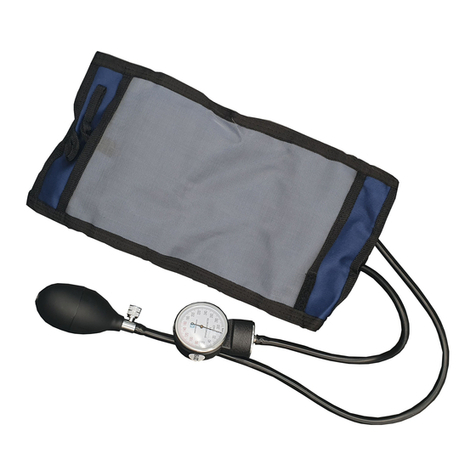
Westmed
Westmed 5810000 instruction manual

Brainlab
Brainlab 18099-02C instruction manual
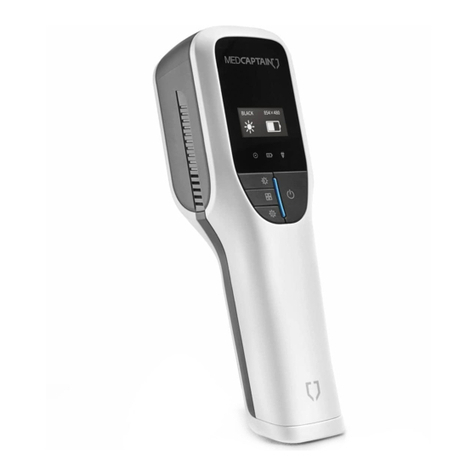
ZONE Medical
ZONE Medical MEDCAPTAIN NAVI-30 Operation manual
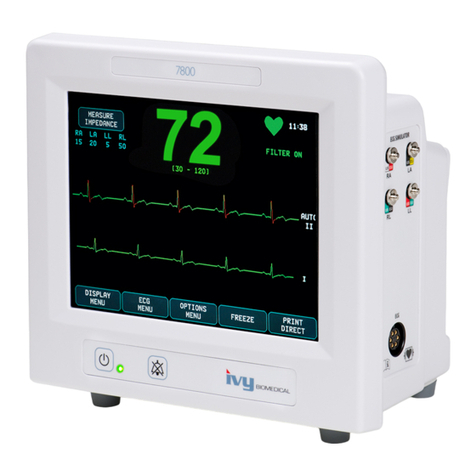
Ivy Biomedical Systems
Ivy Biomedical Systems 7600 Operation manual
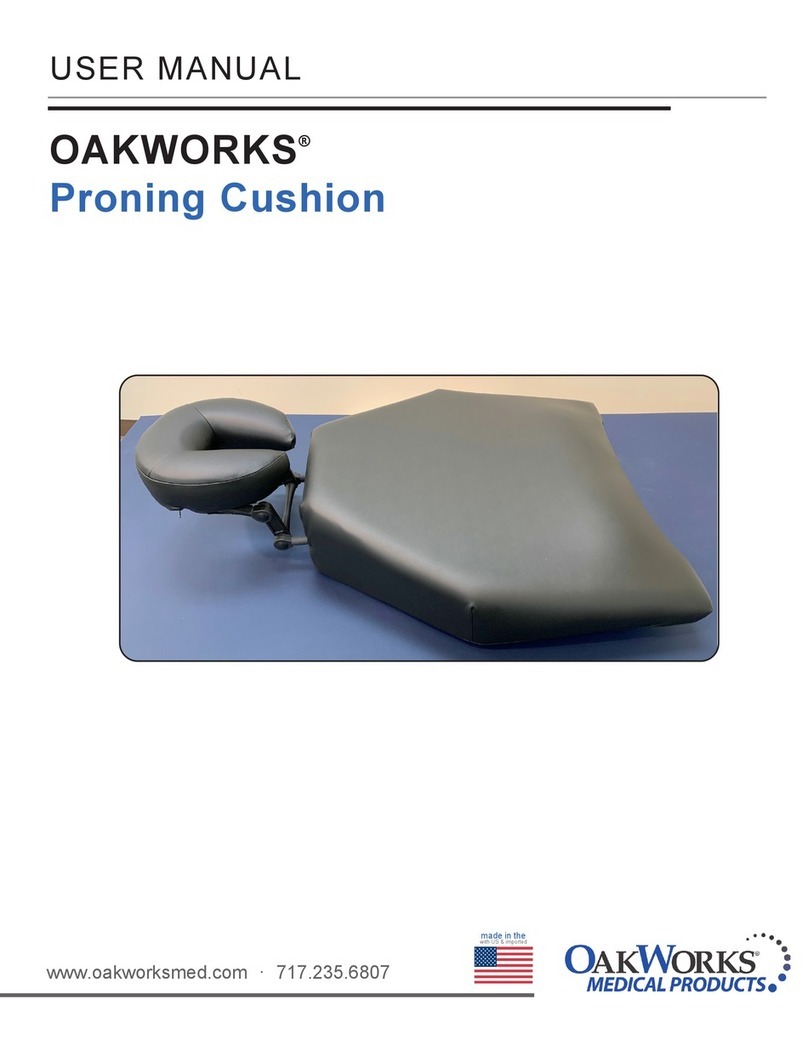
OAKWORKS
OAKWORKS Proning Cushion user manual
